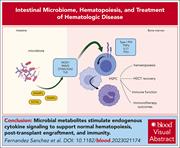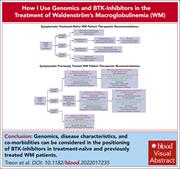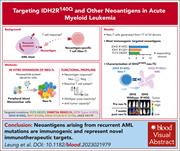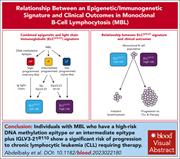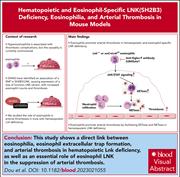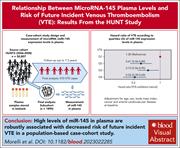Issue Archive
Table of Contents
BLOOD COMMENTARIES
REVIEW ARTICLE
Blood and guts: how the intestinal microbiome shapes hematopoiesis and treatment of hematologic disease
Fernandez Sanchez and colleagues review the complex interaction of the intestinal microbiome and hematopoiesis. Intestinal microbiotas influence blood cell production, trigger cytokine signaling that can influence hematopoiesis, and influence outcomes of stem cell transplantation, immunotherapy, and graft-versus-host disease. The authors highlight these areas and discuss how further research can elucidate ways to reduce adverse effects of antibiotic use to improve hematologic outcomes.
HOW I TREAT
How I use genomics and BTK inhibitors in the treatment of Waldenström macroglobulinemia
Using 4 illustrative cases, Treon and colleagues discuss their approach to therapy in patients with Waldenström macroglobulinemia (WM) based on genomic profile, focusing on mutations in MYD88, CXCR4, and TP53. They present algorithms for sequencing of Bruton tyrosine kinase inhibitors (BTKi’s) based on genomic profile and whether the patient is treatment naïve or previously treated, with consideration of BTKi toxicity.
CLINICAL TRIALS AND OBSERVATIONS
Durable response after tisagenlecleucel in adults with relapsed/refractory follicular lymphoma: ELARA trial update
Clinical Trials & Observations
Dreyling et al report on longer-term follow-up of the phase 2 ELARA trial of tisagenlecleucel (tisa-cel) for treatment of relapsed/refractory (R/R) follicular lymphoma (FL) in third-line or later therapy. They report on 97 patients treated with tisa-cel for R/R FL that relapsed after autologous transplantation. Median progression-free survival, duration of response, and overall survival were not reached after a median follow-up of 29 months, confirming durable efficacy, especially in patients achieving complete remission. Low levels of exhausted T cells and high levels of naïve CD8+ T cells predicted better outcomes.
IMMUNOBIOLOGY AND IMMUNOTHERAPY
Targeting IDH2R140Q and other neoantigens in acute myeloid leukemia
Immunotherapy for acute myeloid leukemia (AML) is difficult, as most target surface antigens are expressed on normal stem cells as well as leukemic blasts. Leung et al explored the targeting of neoantigens created by AML driver mutations and identified IDH2R140Q as an immunodominant neoantigen that can be targeted in an HLA-restricted manner by reactive T cells, leading to in vitro and in vivo killing. These proof-of-concept studies support further investigation of neoantigen-specific T cells to treat relapsed/refractory AML.
LYMPHOID NEOPLASIA
CD371-positive pediatric B-cell acute lymphoblastic leukemia: propensity to lineage switch and slow early response to treatment
Clinical Trials & Observations
Prediction of outcomes for high-count monoclonal B lymphocytosis using an epigenetic and immunogenetic signature
Brief Report
Monoclonal B-cell lymphocytosis (MBL) progresses to chronic lymphocytic leukemia at a low rate (1%-5%/year), and improved prediction of those patients whose disease is prone to progress will have a significant impact on patients with MBL. Abdelbaky and colleagues combined epigenetic and light-chain immunoglobulin signatures of 219 individuals with MBL and defined a high-risk group that has a significantly shorter time to therapy and reduced overall survival. This offers the opportunity to provide better prognostic information to patients and tailor their follow-up.
THROMBOSIS AND HEMOSTASIS
Hematopoietic and eosinophil-specific LNK(SH2B3) deficiency promotes eosinophilia and arterial thrombosis
Dou and colleagues examined the mechanism of eosinophilia and cardiovascular disease associated with a variant in LNK (R262W, T allele). Hematopoietic Lnk deficiency increases circulating and activated eosinophils, increases JAK/STAT signaling, and promotes carotid arterial thrombosis with thrombi enriched for eosinophils and extracellular trap formation (EETosis) in mice. All of these findings are attenuated by eosinophil depletion. These studies link eosinophilia, EETosis, and atherothrombosis and suggest an important role of eosinophil LNK in suppressing arterial thrombosis.
High microRNA-145 plasma levels are associated with decreased risk of future incident venous thromboembolism: the HUNT study
Clinical Trials & Observations
MicroRNA-145 (miR-145) downregulates tissue factor and factor XI expression in vitro and decreases thrombus formation in animal models. Morelli et al investigated the association between variability of miR-145 plasma levels and venous thromboembolism (VTE) risk in a case-cohort study derived from the Trøndelag Health Study. They report that participants in the highest quartile had a 49% lower risk of VTE. miR-145 protects from VTE and provides a novel target for VTE prevention.
BLOOD WORK
ERRATUM
-
Cover Image
Cover Image
![issue cover]()
Representative image of fibrinogen (red) and DAPI (4′,6-diamidino-2-phenylindole; blue) staining in carotid artery thrombi of
Lnk −/− mice. See the article by Dou et al on page 1758. - PDF Icon Front MatterFront Matter
- PDF Icon Table of ContentsTable of Contents
- PDF Icon Editorial BoardEditorial Board
Advertisement intended for health care professionals
Email alerts
Advertisement intended for health care professionals


